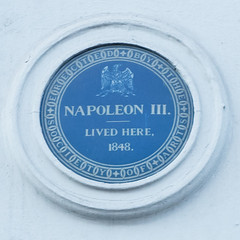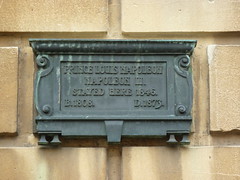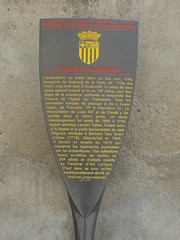Louis-Napoléon Bonaparte


Louis-Napoléon Bonaparte
(1808-1873)
Prince of France (until 1848), Prince of Denmark (until 1810), and 1st Emperor of the French (1852-1870)
Family tree
Commemorated on 7 plaques
Napoleon III lived here 1848
1c King Street, St James's, Westminster, SW1, London, United Kingdom where they lived
Charles Louis Napoleon Bonaparte (1808-1873) Napoleon III Emperor of the French stayed here 1838-1839
Napoleon III House - Clarendon Square, Royal Leamington Spa, United Kingdom where they stayed
Prince Louis Napoleon Napoleon III. Stayed here 1846. B.1808. D.1873.
Sydney Place, Bath, United Kingdom where they stayed (1845)
Palais de l'Archevêché L'archevêché fut établi dans ce lieu vers 1340, transporté du faubourg de la Seds, dit "Ville des Tours", trop isolé face à l'insécurite. Le Palais fut sans cesse agrandi jusqu'à la fin du 18e siècle, pour être digne de la puissance spirituelle et temporelle des Princes de l'église qui l'habitaient. Tous les souverains français de passage à Aix y furent logés, de François 1er à Napoléon III. La réconciliation de Louis XIV et de Condé y fut scellée dans le Salon jaune. Un vaste réaménagement fut mené de 1650 à 1730, auquel participa Laurent Vallon. Durant celluici la façade et la porte monumentale de style Régence attribuée à Bernard Toro furent créées (1715). Sécularisé en 1905, il devint un musée en 1910 qui conserve les tapisseries possédées par les archevêques. Ces collections furent enriches de textiles du 20e siècle et d'objets relatifs au Festival d'Art Lyrique. C'est dans sa cour qu'est traditionnellement abrité ce festival international.
English translation: Palace of the Archbishop The archbishop was established in this place around 1340, transported from the suburb of the Seds, called “City of Tours”, too isolated in the face of the insecurity. The Palace was constantly enlarged until the end of the 18th century, to be worthy of the spiritual and temporal power of the Princes of the Church who inhabited it. All the French rulers passing through Aix were housed there, from Francis 1st to Napoleon III. The reconciliation of Louis XIV and Condé was sealed in the Yellow Salon. A major redevelopment was carried out from 1650 to 1730, in which Laurent Vallon participated. During cellici the façade and the monumental Regency-style door attributed to Bernard Toro were created (1715). Secularized in 1905, it became a museum in 1910 that preserves the tapestries owned by the archbishops. These collections were enriched with 20th century textiles and objects related to the Lyric Art Festival. This international festival is traditionally housed in its courtyard. [AWS Translate]
Musée des Tapisseries - Palais de l'Archevêché - Place des Martyrs de la Resistance, Aix-en-Provence, France where they passed through
Napoleon III Empereur Des Francais vecut a Camden Place de 1871 a 1873. Il y mourut le 9 Janvier 1873. L'Imperatrice Eugenie y vecut de 1870 a 1881. Le Prince Imperial y vecut de 1870 a 1879. Il mourut heroiquement en Afrique Du Sud sous l'uniforme Britannique
English translation: Napoleon III Emperor of the French lived in Camden Place from 1871 to 1873. He died there on January 9, 1873. The Imperatrice Eugenie lived there from 1870 to 1881. The Prince Imperial lived there from 1870 to 1879. He died heroically in South Africa Under the British uniform
Camden Place, London, United Kingdom where they lived (1871-1873) and died (1873)
Lord Street Boulevard The exiled Prince Louis Napoleon lived in Southport in 1838 and admired the long straight wide tree-lined Lord Street. Later he remembered Lord Street's elegance when he returned to France as Emperor and he transformed Paris with its now famous Boulevards.
Lord Street junction Duke Street, Southport, United Kingdom where they lived and visited
Lord Warden Hotel 1853-1939 Napoleon III Emperor of France was reunited here with his wife Princess Eugenie on his exile to England 1871.
Lord Warden House, Lord Warden Square, Dover, United Kingdom where they was






